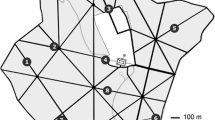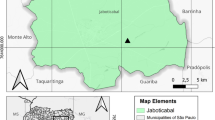Abstract
The method of standardized baited pitfall, traps for monitoring population ofHylobius abietis (L.) was experimentally included into the routine planting and control schedule (model area) in the Czech Republic. It is recommended to determine characteristics of the area on the basis of long-term monitoring. A short-term prognosis per site must be drawn from monitoring done from the earliest beginning of the season. However, it seems advisable to treat all the individual seedlings immediately after theyhave been planted in the area where the over-all characteristics (ascertained by monitoring) indicate generally high population levels. To base a decision for treatment on the percentage of seedlings attacked (feeding scars) per site is considered unadvisable in comparison with data obtained bymonitoring using baited pitfall traps. Insecticides for the treatment of newly planted seedlings need to be applied to two-thirds of the trunk of a seedling (including the root collar), their action should be fast enough to paralyse (kill) the weevils before they reach xylem by feeding and, furthermore, the residues should be effective up to the end of the season.
Similar content being viewed by others
References
Eidmann, H. H., 1974:Hylobius Schönh., pp. 275–293. In:Schwenke, W. (edit.): Die Forstschädlinge Europas. Vol. 2. P. Parey, Hamburg, Berlin.
Mrácek, Z., 1986: Synthetic pyrethroids in the protection of conifers against the large pine weevil. TEI Bull. Tech. Econ. Inform.2, 1–7; Res. Inst. For. Game, Jiloviste-Strnady, Praha, CR.
Mrácek, Z., 1990: Control of the pine weevil and its utilisation in practice. Lesn. práce69, 354–359.
Nordenhem, H., 1989: Age, sexual development, and seasonal occurrence of the pine weevilHylobius abietis (L.). J. Appl. Ent.108, 260–270.
Nordlander, G., 1987: A method for trappingHylobius abietis (L.) with a standardized bait and potential for forecasting feeding damage. Scand. J. For. Res.2, 199–213.
Solbreck, C., 1980: Dispersal distances of migrating pine weevils,Hylobius abietis, Coleoptera: Curculionidae. Entomol. exp. & appl.28, 123–131.
Solbreck, C.;Gyldberg, B., 1979: Temporal flight pattern of the large pine weevilHylobius abietis (L.) (Coleoptera: Curculionidae), with special reference to the influence of weather. J. Appl. Ent.88, 532–536.
Zumr, V.;Stary, P.;Dostálková, I. (1994): Monitoring ofHylobius abietis (L.), (Col., Curculionidae) populations by two types of baited pitfall traps. Anz. Schädlingskde., Pflanzenschutz, Umweltschutz67, 90–92.
Zumr, V.; Stary, P., 1994: Monitoring and seasonal occurrence ofHylobius abietis (L.) (Col., Curculionidae) in different environments of a model forest area. J. Appl. Ent. (in press).
Author information
Authors and Affiliations
Additional information
With one figure and 3 tables
Rights and permissions
About this article
Cite this article
Zumr, V., Stary, P. MonitoringHylobius abietis (L.) (Col., curculionidae) by baited pitfall traps in relation to planting and treatment of seedlings in a re-forested area. Anz. Schadlingskde., Pflanzenschutz, Umweltschutz 68, 18–21 (1995). https://doi.org/10.1007/BF01980351
Issue Date:
DOI: https://doi.org/10.1007/BF01980351




